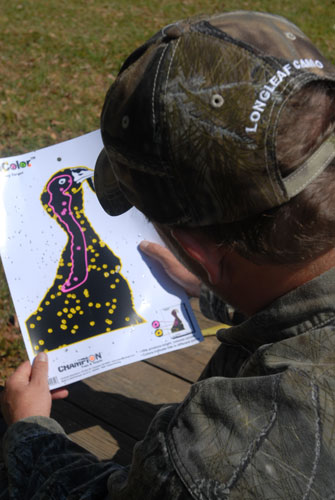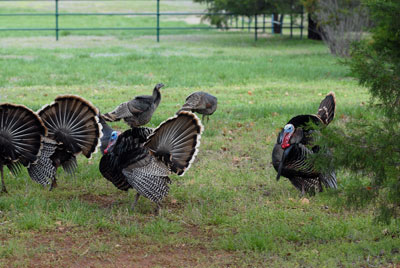Pattern Your Shotgun

One of the most essential and overlooked aspects of a successful turkey hunt is knowing the capabilities of your shotgun. This can be easily accomplished with a few targets and some different brands of shotgun shells, since various loads perform differently. Patterning your shotgun will tell you three things: Where your load hits in relation to your aiming point, the effective range of your gun, and which brand of shell and shot size performs best in your shotgun.
Most shotguns pattern well with 4s, 5s, or 6s, but don’t discount the blended loads. Hevi-Shot’s Magnum Blend utilizes 5s, 6s, and 7s along with a flaxseed buffer that achieves incredible results when fired thru the proper choke tubes. With the variety of after-market choke tubes available, dense patterns out to 40 yards are a reality. Remember the real challenge is to lure a tom within close range for a humane one-shot kill. Patterning a shotgun will enable hunters to learn the limitations of their firearms.
Several companies like TRUGLO offer adjustable turkey sights for shotguns, which enable hunters to fine-tune their weapons for greater accuracy. These bright, fiber-optic sights offer better visibility and quicker target acquisition.
Pre-Season Scouting
Pre-season scouting is one of the most important ingredients to having a successful spring turkey hunt. Knowing the habits of the wild turkeys you are hunting can pay big dividends when the toms are henned-up or during a lull in gobbling activity.
Scouting months in advance is futile, because winter flocks usually break up into smaller flocks just before the season opens. Scout your hunting spots two weeks before season, and do most of your surveillance from a distance so you won’t disturb the turkeys’ daily routines. This can be accomplished with a good set of high-powered binoculars as well as with trail cameras.
Check traditional roosting areas during midday, searching for feathers, tracks and droppings to get an idea if the roost is being used.
Lastly, gather advice from the area’s farmers on the turkeys’ daily routines. Farmers offer a great wealth of information, as they travel the roads daily while farming.
 Pre-Season Calling Educates Turkeys
Pre-Season Calling Educates Turkeys
Never locate toms prior to opening day by calling to them. Though this is an easy way to find turkeys, it is more often detrimental. I know of several hunters who bragged about calling up toms before their season began to get the turkeys “fired-up,” as they put it. When they returned on opening day, the educated turkeys were call-shy. Practice calling turkeys at home, or while commuting to work, but never in the woods before opening day.
Practice Your Turkey Calls To Become Proficient
A few weeks prior to the opening day of spring turkey season is an opportune time to take inventory of the calls and gadgets in your turkey vest. Visit your local sporting goods store to replenish any missing calls. This is also a great time to practice with your calls. If you intend on using a new call, practice with it before going to the woods. Learn to be proficient with it, so you don’t risk educating a wary gobbler.
 If you are a new turkey hunter, there are a number of excellent audio and videotapes available to teach you the art of turkey calling. There are also a number of tutorials available on YouTube as well. Both novices and seasoned hunters need to learn to make the proper calls of a wild turkey. Attending a local turkey-calling contest can also be a beneficial way to learn to make different turkey sounds.
If you are a new turkey hunter, there are a number of excellent audio and videotapes available to teach you the art of turkey calling. There are also a number of tutorials available on YouTube as well. Both novices and seasoned hunters need to learn to make the proper calls of a wild turkey. Attending a local turkey-calling contest can also be a beneficial way to learn to make different turkey sounds.
Prepare For The Swamp Villains
The spring woods are full of God’s creatures, and some consider turkey hunters a good meal. In the Deep South, the creeks and sloughs are guarded by alligators and snakes, but the real deep woods’ villains are the insects. Gnats, chiggers, mosquitoes, biting flies and ticks are annoying and some can carry diseases.
Hunters relying on spray repellants should make sure the product has an adequate amount of DEET. Caution is advised when using DEET however, as concentration strengths vary, and sometimes DEET can be absorbed through the skin.
Another choice for repelling insects is to wear a bug suit. These tightly-knit, meshed outfits serve as a thin “body armor” to protect you from bites.
Better yet, the best choice is to use a ThermaCell. This handy, butane-charged device heats up and spreads repellant. Gone is the need to apply stinky bug sprays on your clothing and skin.
Either way you choose, be prepared so insects don’t spoil your trip, or cause you to swat at them when it’s crunch time with a big gobbler.
Good luck and be safe!






